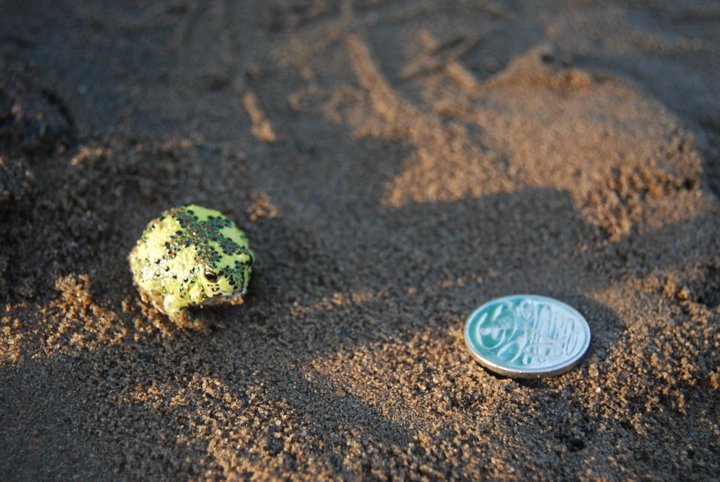Crucifix Toad on:
[Wikipedia]
[Google]
[Amazon]
 The crucifix toad (''Notaden bennettii''), or holy cross frog, is a species of
The crucifix toad (''Notaden bennettii''), or holy cross frog, is a species of
Catalyst. 3 August 2006. The crucifix toad's diet primarily consists of
 The crucifix toad (''Notaden bennettii''), or holy cross frog, is a species of
The crucifix toad (''Notaden bennettii''), or holy cross frog, is a species of frog
A frog is any member of a diverse and largely carnivorous group of short-bodied, tailless amphibians composing the order Anura (ανοὐρά, literally ''without tail'' in Ancient Greek). The oldest fossil "proto-frog" '' Triadobatrachus'' is ...
in the family Limnodynastidae
Limnodynastidae, commonly known as the Australian ground frogs, is a family of frogs found in Australia, New Guinea, and the Aru Islands. They were formerly considered a subfamily of the Myobatrachidae
Myobatrachidae, commonly known as Austra ...
. It is a fossorial
A fossorial () animal is one adapted to digging which lives primarily, but not solely, underground. Some examples are badgers, naked mole-rats, clams, meerkats, and mole salamanders, as well as many beetles, wasps, and bees.
Prehistoric e ...
frog. It is one of the few Australian frogs to display aposematism
Aposematism is the Advertising in biology, advertising by an animal to potential predation, predators that it is not worth attacking or eating. This unprofitability may consist of any defences which make the prey difficult to kill and eat, suc ...
. It is native to western New South Wales
)
, nickname =
, image_map = New South Wales in Australia.svg
, map_caption = Location of New South Wales in AustraliaCoordinates:
, subdivision_type = Country
, subdivision_name = Australia
, established_title = Before federation
, es ...
and south-western Queensland
)
, nickname = Sunshine State
, image_map = Queensland in Australia.svg
, map_caption = Location of Queensland in Australia
, subdivision_type = Country
, subdivision_name = Australia
, established_title = Before federation
, established_ ...
.
It was first described in 1873 by Albert Günther
Albert Karl Ludwig Gotthilf Günther Fellow of the Royal Society, FRS, also Albert Charles Lewis Gotthilf Günther (3 October 1830 – 1 February 1914), was a German-born British zoologist, ichthyologist, and herpetologist. Günther is ranked th ...
.
Description
The crucifix toad is the most distinctive species of frog within the genus ''Notaden
''Notaden'' is a genus of burrowing ground frogs native to central and northern Australia. Their common name is Australian spadefoot toads.
Description
Its body is very round in shape with a short neck. Its pupils are horizontal slits. It h ...
''. Whereas most ''Notaden'' frogs are dark brown in colour, the crucifix toad exhibits many bright colours. Its dorsal surface is bright yellow, with a cross of many colours centered on the back. The cross is outlined with large, black dots, and filled with white, black and red dots. The ventral surface is white, and the flanks blue.
The crucifix toad is a small, and very round frog. Its nose is blunt, and legs and feet are small. As this species is fossorial, the tympanum is hidden. Males reach a length of , and females a length of . The species feet have little "spades" to help them burrow deeply.
Ecology and behaviour
The crucifix toad is a ground-dwelling frog which inhabits the arid areas of western New South Wales and Queensland. It is able to survive dry periods by burrowing and reducing activity. Upon very heavy rain, they will emerge from the ground, and begin breeding in temporary ponds. The males call from within the pond to attract the female. The call is a "woop". The development of the tadpole is rapid so as to take advantage of the wet conditions and reducing the risk of them dying from the pond drying up. The cycle is so quick it can be over in six weeks. The frog exudes a tacky and elastic "frog glue" onto its dorsal skin when provoked. Its purpose is uncertain; it may be intended to confuse and deter predators such as snakes, or to trap biting insects (which would later be consumed when the frog sheds and eats its skin). Male crucifix toads have been documented to use this glue to attach themselves onto the larger females during mating. The glue has been found to be stronger than available non-toxic medical adhesives and is the subject of further study. The glue is aprotein
Proteins are large biomolecules and macromolecules that comprise one or more long chains of amino acid residues. Proteins perform a vast array of functions within organisms, including catalysing metabolic reactions, DNA replication, respon ...
-based pressure-sensitive adhesive
Pressure-sensitive adhesive (PSA, self-adhesive, self-stick adhesive) is a type of nonreactive adhesive which forms a bond when pressure is applied to bond the adhesive with a surface. No solvent, water, or heat is needed to activate the adhesiv ...
that functions even in wet conditions.Frog GlueCatalyst. 3 August 2006. The crucifix toad's diet primarily consists of
ant
Ants are eusocial insects of the family Formicidae and, along with the related wasps and bees, belong to the order Hymenoptera. Ants evolved from vespoid wasp ancestors in the Cretaceous period. More than 13,800 of an estimated total of 22,0 ...
s and termite
Termites are small insects that live in colonies and have distinct castes ( eusocial) and feed on wood or other dead plant matter. Termites comprise the infraorder Isoptera, or alternatively the epifamily Termitoidae, within the order Blat ...
s.
See also
*List of amphibians
Amphibians are ectothermic, tetrapod vertebrates of the class Amphibia. All living amphibians belong to the group Lissamphibia. They inhabit a wide variety of habitats, with most species living within terrestrial, fossorial, arboreal or fres ...
References
Further reading
* {{Taxonbar, from=Q1736313 Notaden Amphibians of Queensland Amphibians of New South Wales Amphibians described in 1873 Taxa named by Albert Günther Frogs of Australia